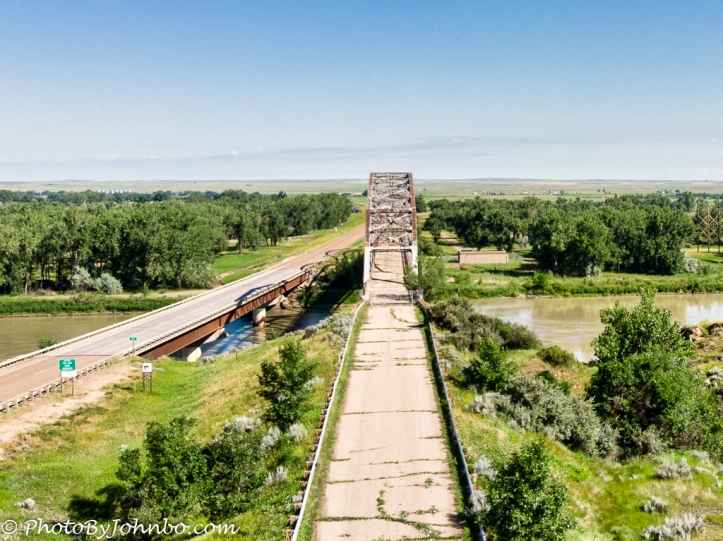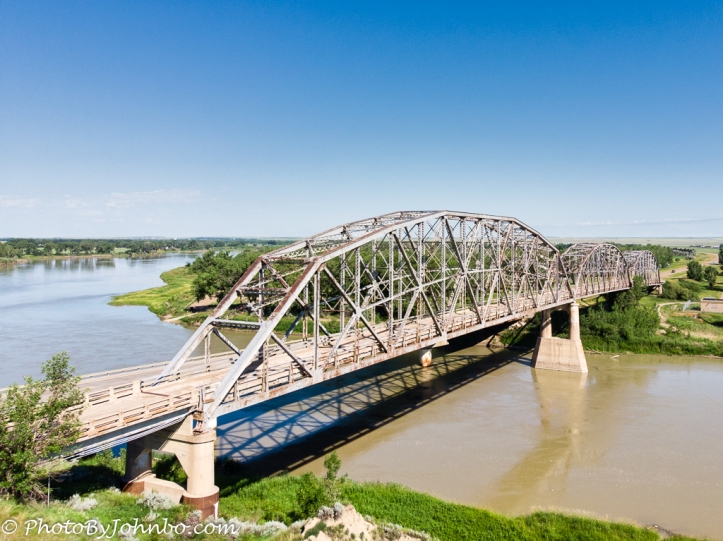On a July trip to Montana, we traveled through the town of Wolf Point. At the Missouri River crossing between Roosevelt and McCone counties, we passed by a small park that led to the original Wolf Point Bridge. On our return home, we stopped to check out the bridge. A placard posted at the site of the park described some of the basic details of the bridge which I will share with you in a moment. A search on the Internet, however, told a more somber story of how this bridge came to be.
In the 1920s, a ferry service was available for travelers to cross, but it only operated in the warmer months. People needing to cross the river in winter would simply drive across the ice. The Wolf Point city website tells of James and Rolla Cusker. In February 1926, they were returning home from a basketball game. They crossed the river over the ice earlier in the day without incident. On their return trip, however, the river claimed their car. Their bodies were not recovered for several days.
A group of citizens took up the cause of providing a safe, year-around method for crossing the river, and brought the request to the Montana Highway Commission. The bridge was included in a request to join the towns of Wolf Point and Circle by a north-south highway. Construction began in 1929 and the Wolf Point Bridge was dedicated on July 9, 1930. More on the development of the project can be found here.
Though not the longest bridge in the state, the bridge, also known as the Old Lewis and Clark Bridge, is the longest Pennsylvania Through Truss bridge in Montana at 1,074 feet (327 m). The two-lane bridge consists of three spans, the longest of which is 400 feet (120 m).
 By the mid-1990s, wider and heavier traffic demanded a major renovation of the bridge. The Highway Commission found a remodel to be cost-prohibitive and opted to build a steel girder, concrete deck bridge that was completed in 1998. You will note from the photo above that the new bridge, built only feet from the original span, is not adorned with decorations.
By the mid-1990s, wider and heavier traffic demanded a major renovation of the bridge. The Highway Commission found a remodel to be cost-prohibitive and opted to build a steel girder, concrete deck bridge that was completed in 1998. You will note from the photo above that the new bridge, built only feet from the original span, is not adorned with decorations.
The original bridge was given to the Montana Historical Society who now maintains the small park at the south end of the bridge. Historical markers provide a historical perspective to travelers who take the time to stop and visit. The bridge has fences to keep vehicles off, but it is open to pedestrian traffic. There are no basic facilities at the historical park site, so plan accordingly. It is only a 10-minute drive from the site of the bridge to the town of Wolf Point.
John Steiner


I see peolpe drive out on the ice here in their pick-ups. I know in theory the ice is thick enough but i just can’t get out there in my little Corolla.
I am with you, maybe more so. I don’t walk on the water in the summer… Ain’t gonna do it in winter either. >grin<
I loved reading this post- came here from. Chris’s bridge post (Milford street) and feeling the flow of history d. Ridge development – so sad about the couple that never made it home from the game – and John – make me appreciate the structures and highways we have today! “We’ve come a long way, baby”
It was Milford Street and the Bridgehunter’s Chronicles blogs that led me to festure historic and iconic bridges encountered as I traveled. Thanks for stopping to make a comment!
Oh cool!! And be back again to
Visit later – have a good week
Countless the times when it required a tragedy to prompt the authorities into action…
Indeed. And many government safety regulations are written with the blood of victims.
[…] Wolf Point Bridge – Born out of Tragedy — Journeys with Johnbo […]